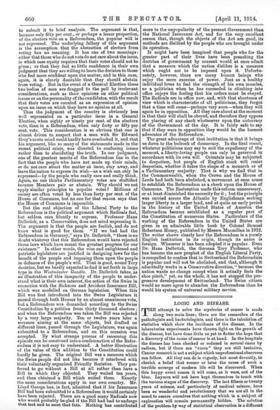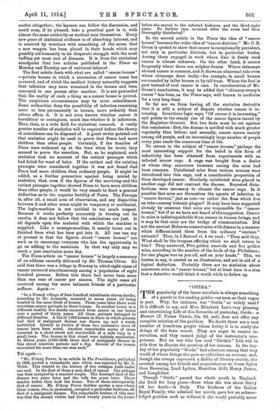LOGIC AND DISEASE.
MILE attempt to solve the mysteries of cancer is made 1. along two main lines ; there are the researches of the pathologists and bacteriologists, and there is the tabulation of' statistics which show the incidence of the disease. In the laboratories experiments have thrown light on the growth of the disease, but have done little as yet to flatter the hope that a discovery of the cause of cancer is at hand. In the hospitals the disease has been checked or reduced in several cases by radium, but if there are "cures" they are still tentative. Cancer research is not a subject which unprofessional observers can follow. All they can do is vaguely, but most devoutly, to cherish a belief that sooner or later the cause of such a terrible scourge of modern life will be discovered. When this happy event comes it will come, as it were, out of the blue. Laymen will not have kept themselves in touch with the various stages of the discovery. The last fifteen or twenty years of science, and particularly of medical science, have been so wonderful and revolutionary that we are all in the mood to assure ourselves that nothing which is a subject of exploration will remain permanently hidden. The solution of the problem by way of statistical observation is a different matter altogether; the layman can follow the discussion, and could even, if he pleased, take a practical part in it, with almost the same authority as medical men themselves. Every new piece of statistical evidence is of absorbing interest, and is received by watchers with something of the sense that a new weapon has been placed in their hands which may possibly aid humanity in its desperate struggle with the most baffling yet most real of diseases. It is from the statistical standpoint that two articles published in the Times on Monday and Tuesday are of universal interest. The first article deals with what are called "cancer houses" —private houses in which a succession of cancer cases has occurred, and of which the medical history naturally suggests that infection may have remained in the houses and been conveyed to one person after another. It is not pretended that the reality of such a thing as a cancer house is proved. The suspicious circumstances may be mere coincidences. Some authorities deny the possibility of infection remaining more or less permanently in houses, more ardently than others affirm it. It is not even known whether cancer is hereditary or contagious, much leas whether it is infections. Here, then, is a wide field for statistical research. A. vastly greater number of statistics will be required before the theory of coincidence can be disposed of. A great writer pointed out that statistics might be used to prove that Peers had more children than other people. Certainly, if the families of Peers were reckoned up at the time when he wrote, they seemed to prove the assertion. But, as he explained, such statistics took no account of the extinct peerages which had failed for want of heirs. If the extinct and the existing peerages were considered together it was not found that Peers had more children than ordinary people. It might be added, as a further precaution against being misled by statistics, that, even if the figures of the surviving and the extinct peerages together showed Peers to have more children than other people, it would be very unsafe to draw a general deduction as to the superior fertility of Peers. The Peerage is, after all, a small area of observation, and any disparities between it and other areas might be temporary or accidental The logic-machine is not entitled to too much respect. Because it works perfectly accurately in turning out its results, it does not follow that the conclusions are just. It all depends upon the material with which the machine is supplied. Like a sausage-machine, it merely turns out in finished form what has been put into it. All one can say at present is that the figures about "cancer houses" are such as to encourage everyone who has the opportunity to go on adding to the materials. In that way only may we reach a just conclusion some day. The Times article on "cancer houses" is largely a summary of an address recently delivered by Sir Thomas Oliver. He said that there was a village in Norway in which eight cases of cancer occurred simultaneously among a population of eight hundred persons. Before this there had never been more than one ease of cancer per annum. The eight oases all occurred among the more intimate friends of a particular sufferer. Again :— " In a French village of four hundred inhabitants eleven deaths, according to Dr. Armaude, occurred in seven years, all being located in the same block of houses. Three years later there were seventeen cancer patients in these houses. In another house in a different locality five deaths occurred from cancer in one house over a period of thirty years. All these patients belonged to different families. A list of 1,062 houses in Paris in which persons had died of malignant disease was drawn up, and a watch instituted. Already in twelve of them two successive cases of cancer have been noted. Another remarkable series of cases occurred in a short street not one-twelfth of a mile long in a small town. The houses in this street were entirely residentiaL In fifteen years (1893-1908) there died of malignant disease in this street nineteen persons and a dog. Several of the houses accounted for more than one case each."
Yet again :—
“ Mr. D'Arcy Power, in an article in The Practitioner, published in 1899, quoted a remarkable case which was reported by Mr. L. Webb. • This related to the history of two cottages built under one roof. In the first of these a man died of cancer. The cottage was then occupied by a married couple. The husband died of the disease two years later and the wife ton years later. Three maiden ladies then took the house. Two of these subsequently died of cancer. Mr. D'Arcy Power further quotes a case where three women who, in succession, occupied a particular bedroom, all died of a malignant disease. The remarkable feature of this case was that the second victim had lived twenty years in the house before she moved to the infected bedroom, and the third eight years. No further ease occurred after the room had been thoroughly disinfected."
In the second article in the Times the ides of "cancer houses" becomes the wider idea of "cancer districts." Mr. C. E. Green is quoted to show that cancer is exceptionally prevalent, not only in particular districts, but in particular trades. Among those engaged in work where lime is freely used cancer is almost unknown. On the other hand, it occurs frequently where there are sulphur-fumes. Where chimneys abound cancer is common, and it shows an abnormal rate even where chimneys draw badly—for example, in small houses surrounded by taller houses or by tall trees. Where the fuel is peat instead of coal cancer is rare. In corroboration of Mr. Green's conclusions, it may be added that "chimney-sweep's cancer" has been, as the Times says, well known to medicine for a very long time.
So far are we from haying all the statistics desirable that it is still a subject of dispute whether cancer is in- creasing. Incautious logic, says, " Of coarse it is increasing." and points to the steady rise of the cancer figures issued by the Registrar-General. But two facts must be set against this conclusion: first, the disease is notified with much greater regularity than before; and secondly, cancer occurs mainly among old people, and an increasingly large number of people every year reach the cancerous time of life.
To return to the subject of "cancer houses," perhaps the most interesting support for the belief in this form of infectivity has been obtained from experiments with an infected mouse cage. A. cage was bought from a dealer at whose shop cancerous tumours among the mice had been common. Uninfected mice from various sources were introduced into this cage, and a considerable proportion of them developed cancer. Similarly, uninfected mice placed in another cage did not contract the disease. Repeated disin- fections were necessary to cleanse the cancer cage. Is it possible that mice are themselves the agents of infection in "cancer houses," just as rats—or rather the fleas which live on rats—convey bubonic plague? It may have been suggested already by someone that mice are responsible for "cancer houses," but if so we have not heard of the suggestion. Cancer in mice is indistinguishable from cancer in human beings, and it may be that mice are the bridge of communication. Did not the ancient Hebrews connect mice with disease in a manner which differentiated them from the ordinary "unclean" animals ? Thus, in 1 Samuel vi. 4 we read: "Then said they, What shall be the trespass offering which we shall return to him ? They answered, Five golden etnerods and five golden mice, according to the number of the lords of the Philistines; for one plague was on you all, and on your heads." This, we hasten to say, is quoted as an illustration, and not in aid of a logical deduction. Probably there are no statistics about cancerous mice in" cancer houses," but at least here is a clue that a detective would think it worth while to follow up.







































 Previous page
Previous page